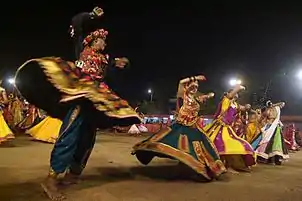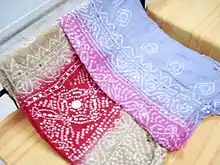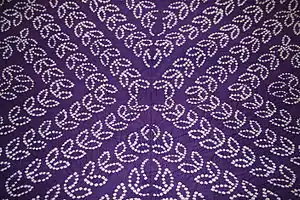Kediyu
The kediyu is a garment worn by men in the rural coastal parts of western Gujarat, including Junagadh district.[1] The kediyu is a long sleeved upper garment, pleated at the chest, which reaches to the waist.[2][3] The prints on the kediyu include bandhani designs which are local to Gujarat and Rajasthan.[4] The kediyu is often worn with chorno, also called kafni, which refers to the pantaloons that are wide and tied loosely at the ankles, and is based on the styles worn in Iraq which were introduced to the coastal region during the 7th century[5] by traders.[6] The chorno/surwal can also be worn with a jama.
%252C_man's_costume%252C_1970s-1980s_-_Bunka_Gakuen_Costume_Museum_-_DSC05310.JPG.webp) India (Gujarat), man's kediyu suruwal, Bunka Gakuen Costume Museum
India (Gujarat), man's kediyu suruwal, Bunka Gakuen Costume Museum Man on the left in jama and chorno (jama/suruwal)
Man on the left in jama and chorno (jama/suruwal) Gujarati men in kediyu
Gujarati men in kediyu Bandhani prints
Bandhani prints Bandhani print open
Bandhani print open Traditional Folk dance Garba dress: Man in Kediyu
Traditional Folk dance Garba dress: Man in Kediyu
References
- (India), Gujarat (1 January 1975). "Gujarat State Gazetteers: Junagadh District". Directorate of Government Print., Stationery and Publications, Gujarat State – via Google Books.
- Vachanamrut. ShreeSwaminarayanTemple Bhuj. ISBN 9781291123869 – via Google Books.
- Ahuja, Simran. Nine Nights: Navratri. Notion Press. ISBN 9789383416400 – via Google Books.
- Murphy, Veronica and Crill, Rosemary (1991) Tie-dyed Textiles of India: Tradition and Trad
- Gokhale. Surat In The Seventeenth Century. Popular Prakashan. p. 28. ISBN 9788171542208. Retrieved 23 February 2015.
Islam was introduced into Gujarat in the 7th century A.D. The first Arab raid came in 635 when the Governor of Bahrain sent an expedition against Broach. Then through the centuries colonies of Arab and Persian merchants began sprouting in the port cities of Gujarat, such as Cambay, Broach and Surat.
- Satish Saberwal, Mushirul Hasan (2006) Assertive Religious Identities: India and Europe
See also
- Central Asian clothing
- Chemise
- Chikankari
- Churidar
- Dhoti
- Dupatta
- Gagra choli
- Khet partug
- Kurta
- Perahan tunban
- Kashmiri phiran and poots
- Qamis
- Sari
- Sherwani
- Sirwal
- Turkish salvar
This article is issued from Wikipedia. The text is licensed under Creative Commons - Attribution - Sharealike. Additional terms may apply for the media files.
